Comprehensive Strategic Management Report on Tesco PLC Analysis
VerifiedAdded on 2021/04/24
|24
|5479
|344
Report
AI Summary
This report provides a comprehensive analysis of Tesco's strategic management, examining its vision, mission, core values, and corporate strategy. It includes a PESTLE analysis to assess the macro-environmental factors influencing Tesco's performance, covering political, economic, social, technological, legal, and environmental aspects. A competitive analysis using Porter's Five Forces framework evaluates the threats of substitute products, new entrants, competitive rivalry, and the bargaining power of buyers and suppliers. The report also explores Tesco's strategic drift, alignment of vision and mission, strategic capabilities, leadership, creativity, organization design, and business canvas model. Furthermore, it discusses strategic choices, Tesco's strategic plan, strategic options, targeting, and positioning strategies. The report concludes with insights into the implementation of the strategic plan, offering a detailed overview of Tesco's strategic landscape and potential future directions. Desklib provides this and similar solved assignments for students.
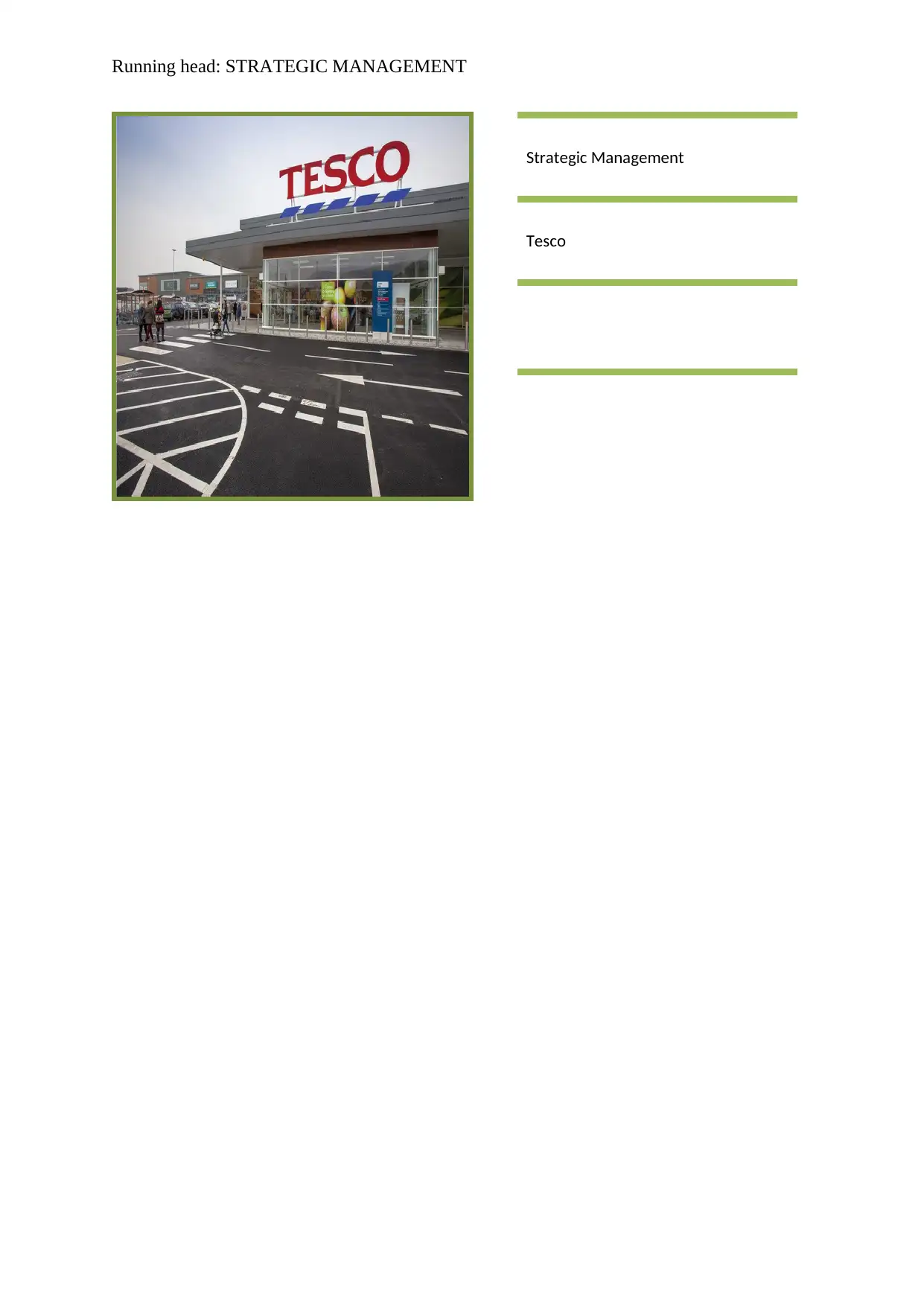
Running head: STRATEGIC MANAGEMENT
Strategic Management
Tesco
Strategic Management
Tesco
Paraphrase This Document
Need a fresh take? Get an instant paraphrase of this document with our AI Paraphraser
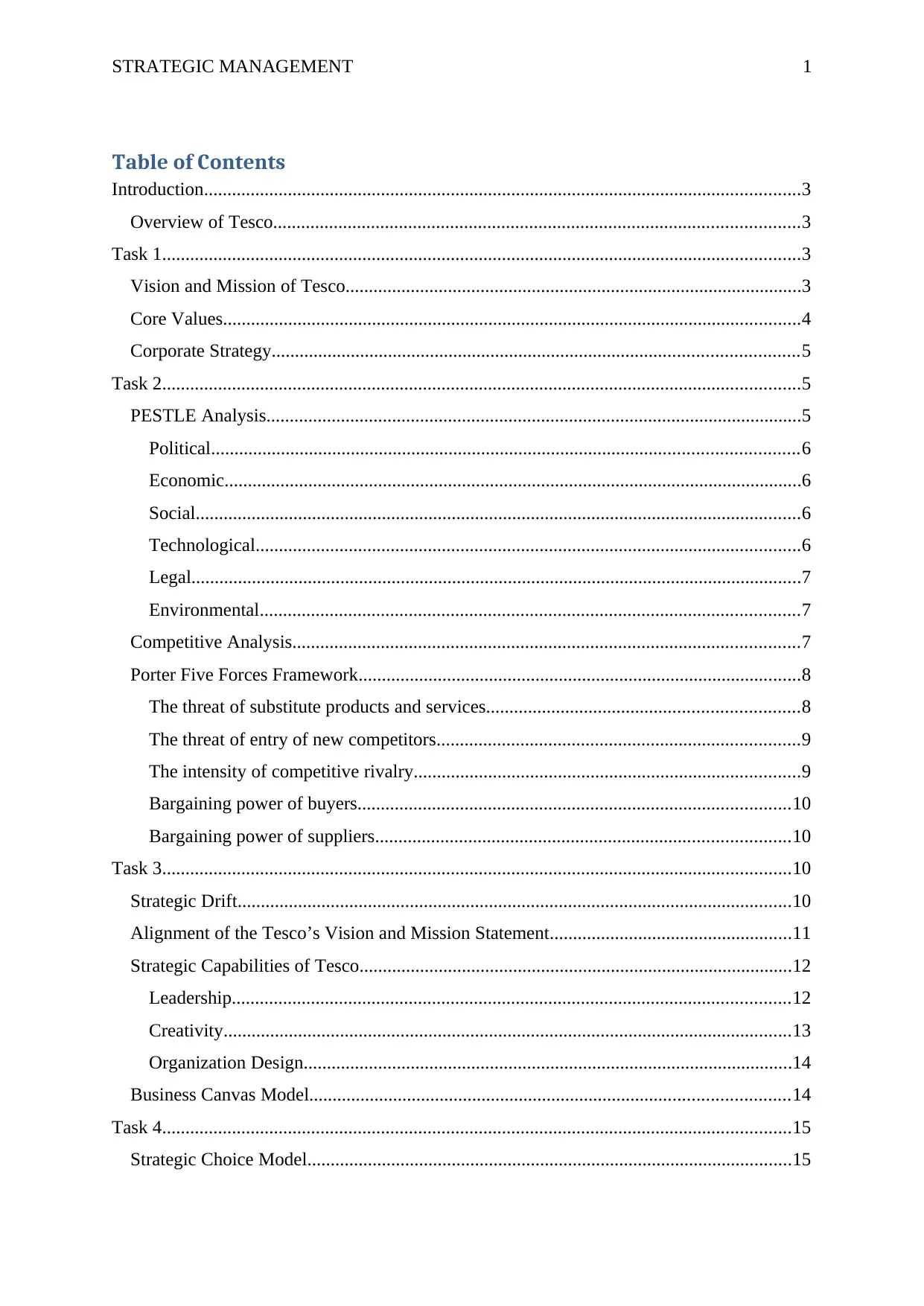
STRATEGIC MANAGEMENT 1
Table of Contents
Introduction................................................................................................................................3
Overview of Tesco.................................................................................................................3
Task 1.........................................................................................................................................3
Vision and Mission of Tesco..................................................................................................3
Core Values............................................................................................................................4
Corporate Strategy.................................................................................................................5
Task 2.........................................................................................................................................5
PESTLE Analysis...................................................................................................................5
Political..............................................................................................................................6
Economic............................................................................................................................6
Social..................................................................................................................................6
Technological.....................................................................................................................6
Legal...................................................................................................................................7
Environmental....................................................................................................................7
Competitive Analysis.............................................................................................................7
Porter Five Forces Framework...............................................................................................8
The threat of substitute products and services...................................................................8
The threat of entry of new competitors..............................................................................9
The intensity of competitive rivalry...................................................................................9
Bargaining power of buyers.............................................................................................10
Bargaining power of suppliers.........................................................................................10
Task 3.......................................................................................................................................10
Strategic Drift.......................................................................................................................10
Alignment of the Tesco’s Vision and Mission Statement....................................................11
Strategic Capabilities of Tesco.............................................................................................12
Leadership........................................................................................................................12
Creativity..........................................................................................................................13
Organization Design.........................................................................................................14
Business Canvas Model.......................................................................................................14
Task 4.......................................................................................................................................15
Strategic Choice Model........................................................................................................15
Table of Contents
Introduction................................................................................................................................3
Overview of Tesco.................................................................................................................3
Task 1.........................................................................................................................................3
Vision and Mission of Tesco..................................................................................................3
Core Values............................................................................................................................4
Corporate Strategy.................................................................................................................5
Task 2.........................................................................................................................................5
PESTLE Analysis...................................................................................................................5
Political..............................................................................................................................6
Economic............................................................................................................................6
Social..................................................................................................................................6
Technological.....................................................................................................................6
Legal...................................................................................................................................7
Environmental....................................................................................................................7
Competitive Analysis.............................................................................................................7
Porter Five Forces Framework...............................................................................................8
The threat of substitute products and services...................................................................8
The threat of entry of new competitors..............................................................................9
The intensity of competitive rivalry...................................................................................9
Bargaining power of buyers.............................................................................................10
Bargaining power of suppliers.........................................................................................10
Task 3.......................................................................................................................................10
Strategic Drift.......................................................................................................................10
Alignment of the Tesco’s Vision and Mission Statement....................................................11
Strategic Capabilities of Tesco.............................................................................................12
Leadership........................................................................................................................12
Creativity..........................................................................................................................13
Organization Design.........................................................................................................14
Business Canvas Model.......................................................................................................14
Task 4.......................................................................................................................................15
Strategic Choice Model........................................................................................................15
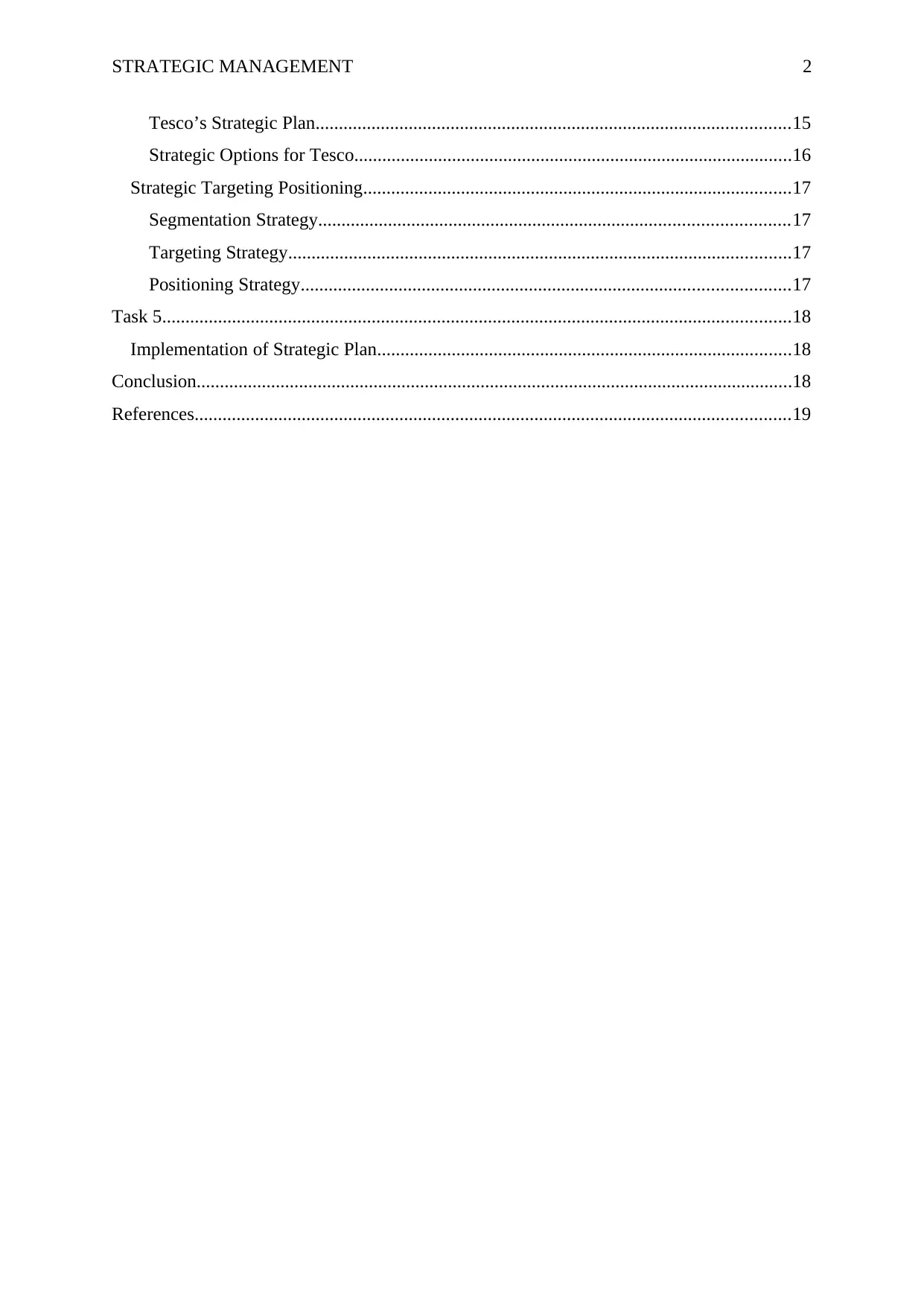
STRATEGIC MANAGEMENT 2
Tesco’s Strategic Plan......................................................................................................15
Strategic Options for Tesco..............................................................................................16
Strategic Targeting Positioning............................................................................................17
Segmentation Strategy.....................................................................................................17
Targeting Strategy............................................................................................................17
Positioning Strategy.........................................................................................................17
Task 5.......................................................................................................................................18
Implementation of Strategic Plan.........................................................................................18
Conclusion................................................................................................................................18
References................................................................................................................................19
Tesco’s Strategic Plan......................................................................................................15
Strategic Options for Tesco..............................................................................................16
Strategic Targeting Positioning............................................................................................17
Segmentation Strategy.....................................................................................................17
Targeting Strategy............................................................................................................17
Positioning Strategy.........................................................................................................17
Task 5.......................................................................................................................................18
Implementation of Strategic Plan.........................................................................................18
Conclusion................................................................................................................................18
References................................................................................................................................19
⊘ This is a preview!⊘
Do you want full access?
Subscribe today to unlock all pages.

Trusted by 1+ million students worldwide
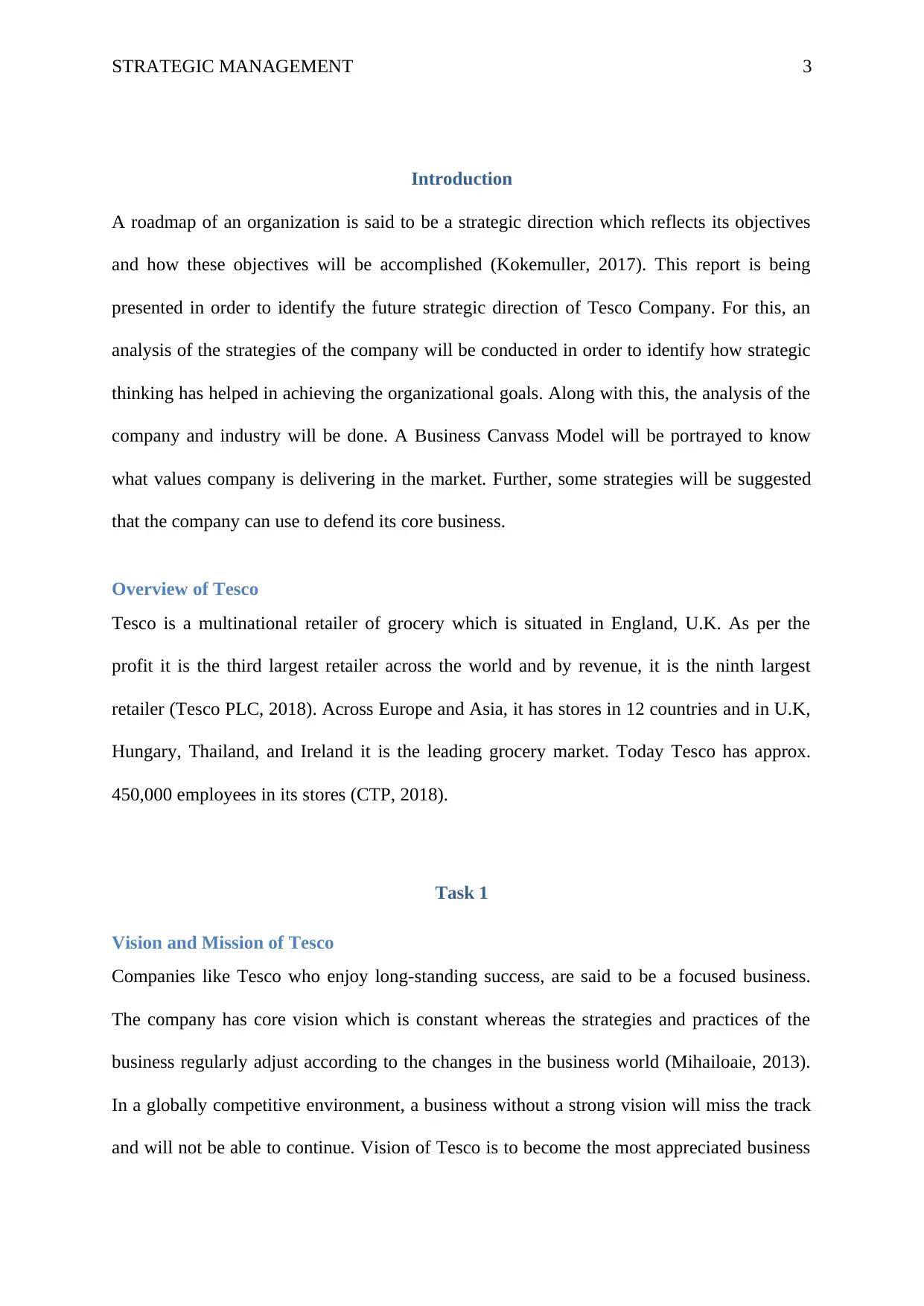
STRATEGIC MANAGEMENT 3
Introduction
A roadmap of an organization is said to be a strategic direction which reflects its objectives
and how these objectives will be accomplished (Kokemuller, 2017). This report is being
presented in order to identify the future strategic direction of Tesco Company. For this, an
analysis of the strategies of the company will be conducted in order to identify how strategic
thinking has helped in achieving the organizational goals. Along with this, the analysis of the
company and industry will be done. A Business Canvass Model will be portrayed to know
what values company is delivering in the market. Further, some strategies will be suggested
that the company can use to defend its core business.
Overview of Tesco
Tesco is a multinational retailer of grocery which is situated in England, U.K. As per the
profit it is the third largest retailer across the world and by revenue, it is the ninth largest
retailer (Tesco PLC, 2018). Across Europe and Asia, it has stores in 12 countries and in U.K,
Hungary, Thailand, and Ireland it is the leading grocery market. Today Tesco has approx.
450,000 employees in its stores (CTP, 2018).
Task 1
Vision and Mission of Tesco
Companies like Tesco who enjoy long-standing success, are said to be a focused business.
The company has core vision which is constant whereas the strategies and practices of the
business regularly adjust according to the changes in the business world (Mihailoaie, 2013).
In a globally competitive environment, a business without a strong vision will miss the track
and will not be able to continue. Vision of Tesco is to become the most appreciated business
Introduction
A roadmap of an organization is said to be a strategic direction which reflects its objectives
and how these objectives will be accomplished (Kokemuller, 2017). This report is being
presented in order to identify the future strategic direction of Tesco Company. For this, an
analysis of the strategies of the company will be conducted in order to identify how strategic
thinking has helped in achieving the organizational goals. Along with this, the analysis of the
company and industry will be done. A Business Canvass Model will be portrayed to know
what values company is delivering in the market. Further, some strategies will be suggested
that the company can use to defend its core business.
Overview of Tesco
Tesco is a multinational retailer of grocery which is situated in England, U.K. As per the
profit it is the third largest retailer across the world and by revenue, it is the ninth largest
retailer (Tesco PLC, 2018). Across Europe and Asia, it has stores in 12 countries and in U.K,
Hungary, Thailand, and Ireland it is the leading grocery market. Today Tesco has approx.
450,000 employees in its stores (CTP, 2018).
Task 1
Vision and Mission of Tesco
Companies like Tesco who enjoy long-standing success, are said to be a focused business.
The company has core vision which is constant whereas the strategies and practices of the
business regularly adjust according to the changes in the business world (Mihailoaie, 2013).
In a globally competitive environment, a business without a strong vision will miss the track
and will not be able to continue. Vision of Tesco is to become the most appreciated business
Paraphrase This Document
Need a fresh take? Get an instant paraphrase of this document with our AI Paraphraser
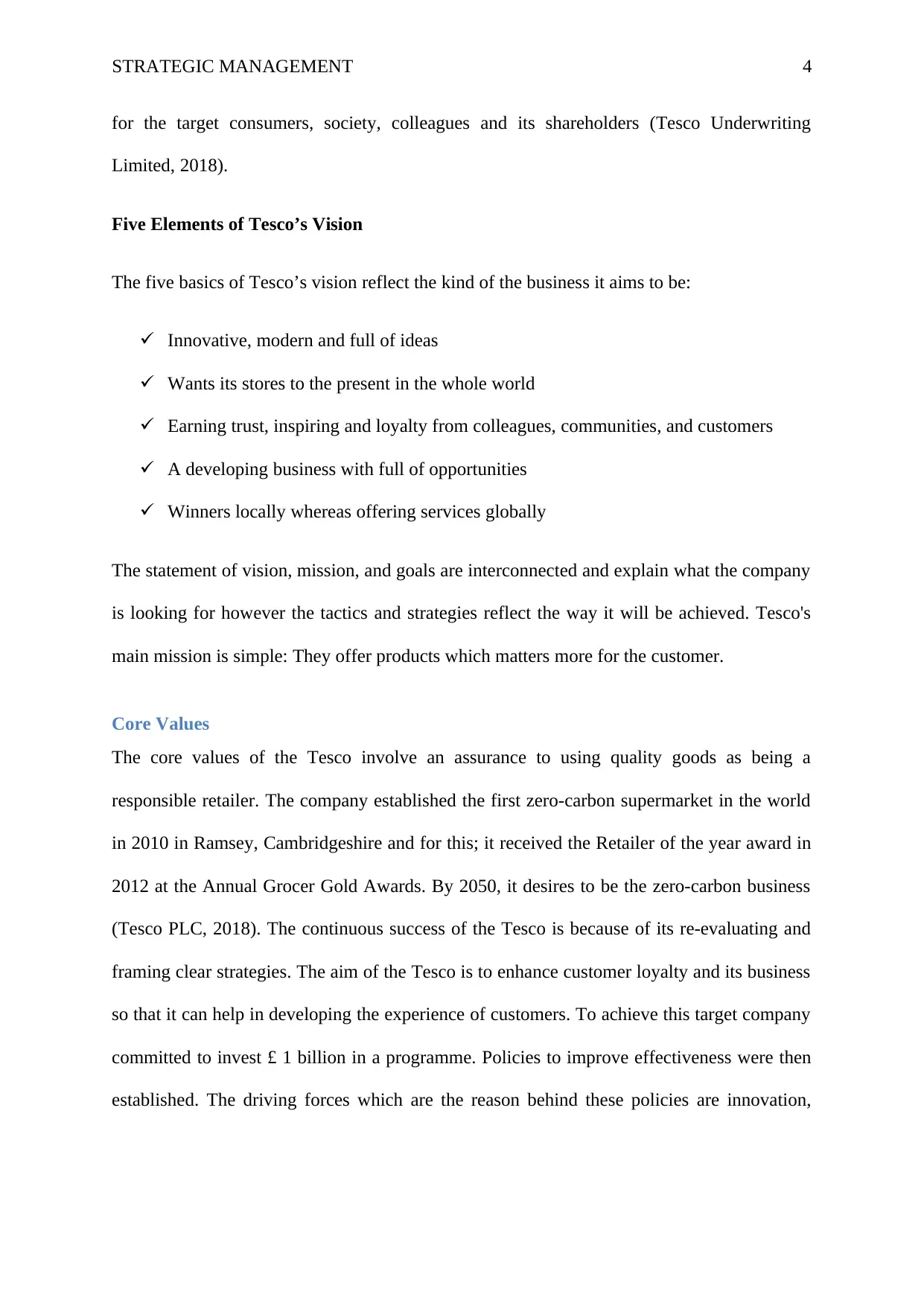
STRATEGIC MANAGEMENT 4
for the target consumers, society, colleagues and its shareholders (Tesco Underwriting
Limited, 2018).
Five Elements of Tesco’s Vision
The five basics of Tesco’s vision reflect the kind of the business it aims to be:
Innovative, modern and full of ideas
Wants its stores to the present in the whole world
Earning trust, inspiring and loyalty from colleagues, communities, and customers
A developing business with full of opportunities
Winners locally whereas offering services globally
The statement of vision, mission, and goals are interconnected and explain what the company
is looking for however the tactics and strategies reflect the way it will be achieved. Tesco's
main mission is simple: They offer products which matters more for the customer.
Core Values
The core values of the Tesco involve an assurance to using quality goods as being a
responsible retailer. The company established the first zero-carbon supermarket in the world
in 2010 in Ramsey, Cambridgeshire and for this; it received the Retailer of the year award in
2012 at the Annual Grocer Gold Awards. By 2050, it desires to be the zero-carbon business
(Tesco PLC, 2018). The continuous success of the Tesco is because of its re-evaluating and
framing clear strategies. The aim of the Tesco is to enhance customer loyalty and its business
so that it can help in developing the experience of customers. To achieve this target company
committed to invest £ 1 billion in a programme. Policies to improve effectiveness were then
established. The driving forces which are the reason behind these policies are innovation,
for the target consumers, society, colleagues and its shareholders (Tesco Underwriting
Limited, 2018).
Five Elements of Tesco’s Vision
The five basics of Tesco’s vision reflect the kind of the business it aims to be:
Innovative, modern and full of ideas
Wants its stores to the present in the whole world
Earning trust, inspiring and loyalty from colleagues, communities, and customers
A developing business with full of opportunities
Winners locally whereas offering services globally
The statement of vision, mission, and goals are interconnected and explain what the company
is looking for however the tactics and strategies reflect the way it will be achieved. Tesco's
main mission is simple: They offer products which matters more for the customer.
Core Values
The core values of the Tesco involve an assurance to using quality goods as being a
responsible retailer. The company established the first zero-carbon supermarket in the world
in 2010 in Ramsey, Cambridgeshire and for this; it received the Retailer of the year award in
2012 at the Annual Grocer Gold Awards. By 2050, it desires to be the zero-carbon business
(Tesco PLC, 2018). The continuous success of the Tesco is because of its re-evaluating and
framing clear strategies. The aim of the Tesco is to enhance customer loyalty and its business
so that it can help in developing the experience of customers. To achieve this target company
committed to invest £ 1 billion in a programme. Policies to improve effectiveness were then
established. The driving forces which are the reason behind these policies are innovation,
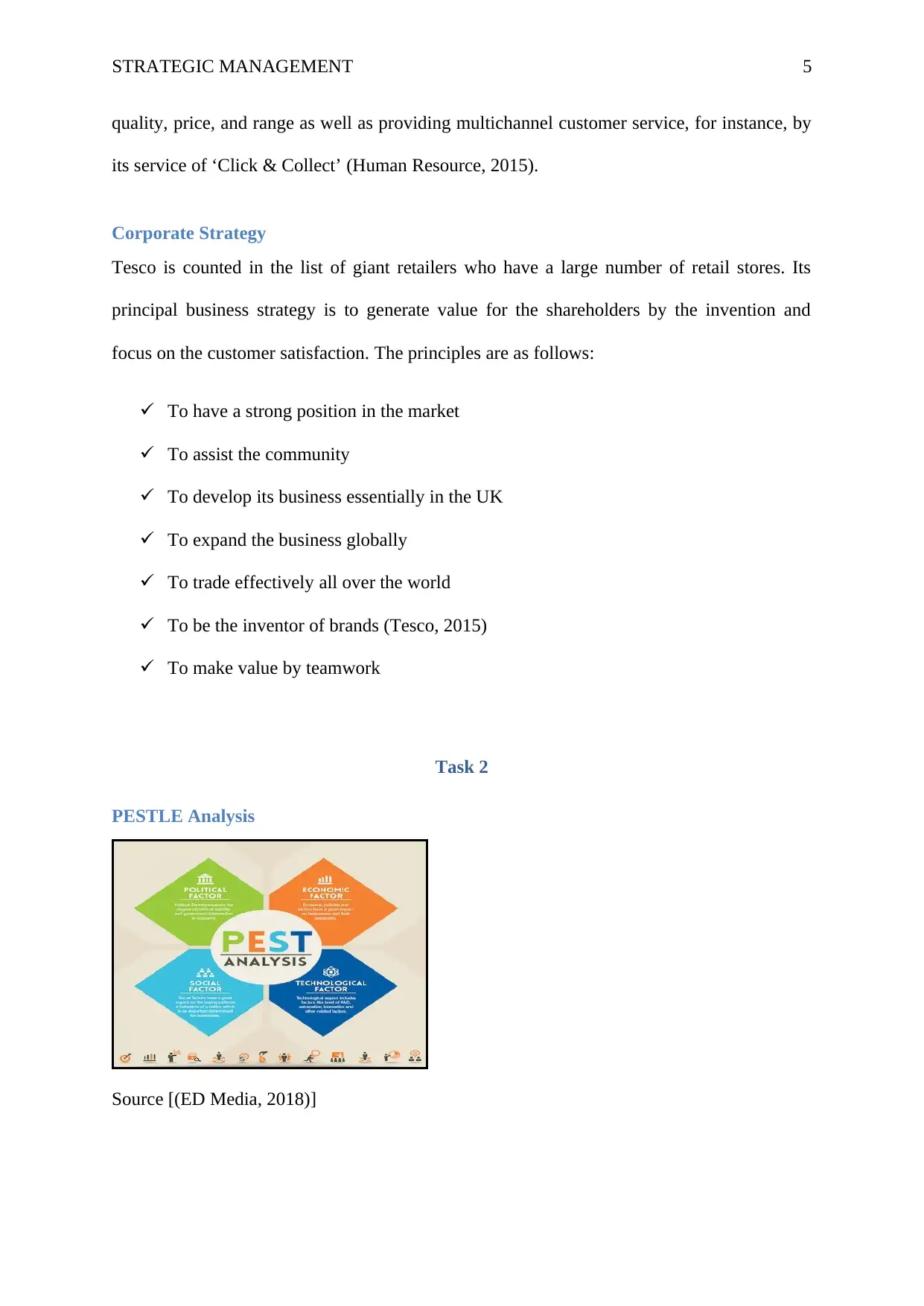
STRATEGIC MANAGEMENT 5
quality, price, and range as well as providing multichannel customer service, for instance, by
its service of ‘Click & Collect’ (Human Resource, 2015).
Corporate Strategy
Tesco is counted in the list of giant retailers who have a large number of retail stores. Its
principal business strategy is to generate value for the shareholders by the invention and
focus on the customer satisfaction. The principles are as follows:
To have a strong position in the market
To assist the community
To develop its business essentially in the UK
To expand the business globally
To trade effectively all over the world
To be the inventor of brands (Tesco, 2015)
To make value by teamwork
Task 2
PESTLE Analysis
Source [(ED Media, 2018)]
quality, price, and range as well as providing multichannel customer service, for instance, by
its service of ‘Click & Collect’ (Human Resource, 2015).
Corporate Strategy
Tesco is counted in the list of giant retailers who have a large number of retail stores. Its
principal business strategy is to generate value for the shareholders by the invention and
focus on the customer satisfaction. The principles are as follows:
To have a strong position in the market
To assist the community
To develop its business essentially in the UK
To expand the business globally
To trade effectively all over the world
To be the inventor of brands (Tesco, 2015)
To make value by teamwork
Task 2
PESTLE Analysis
Source [(ED Media, 2018)]
⊘ This is a preview!⊘
Do you want full access?
Subscribe today to unlock all pages.

Trusted by 1+ million students worldwide
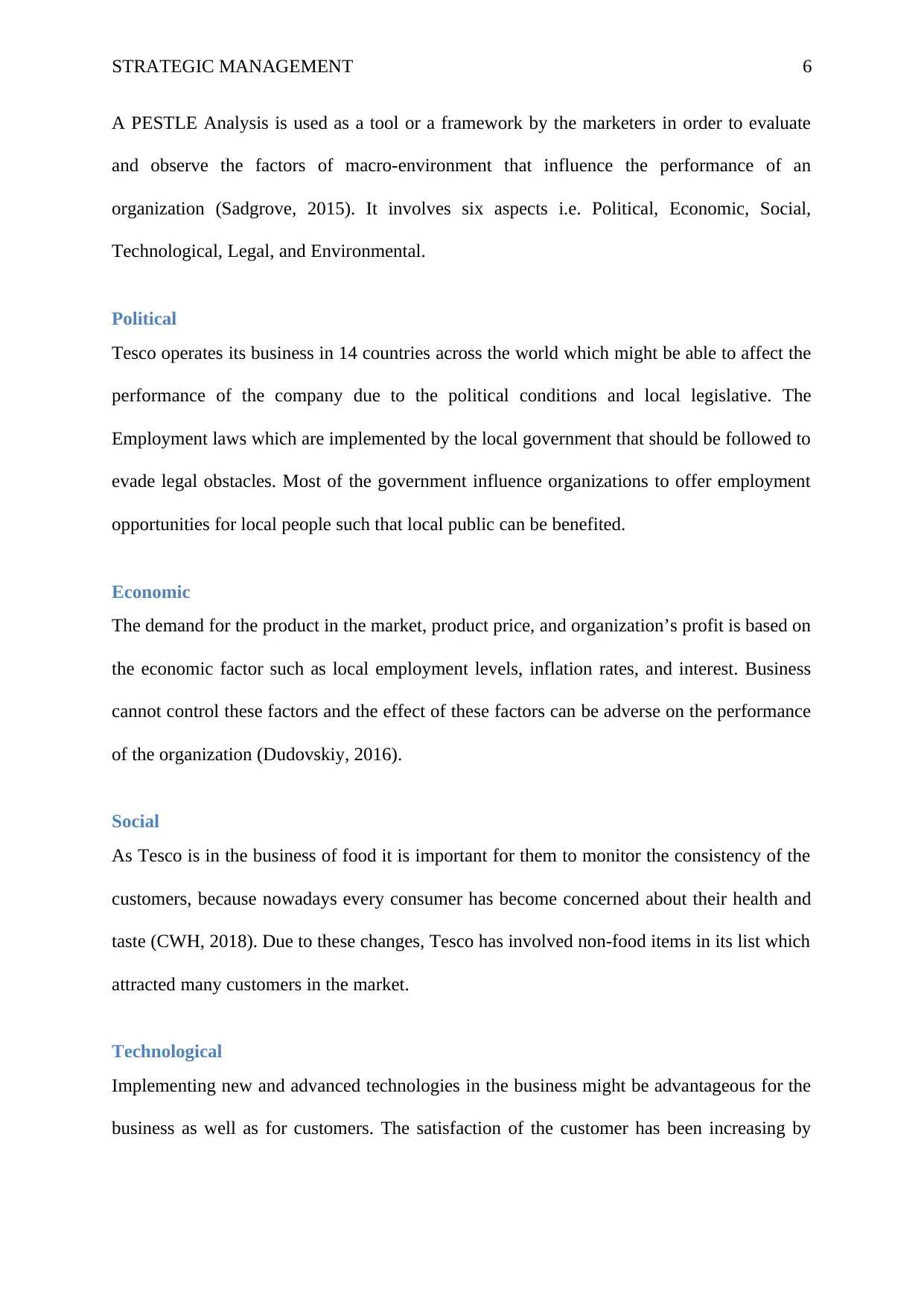
STRATEGIC MANAGEMENT 6
A PESTLE Analysis is used as a tool or a framework by the marketers in order to evaluate
and observe the factors of macro-environment that influence the performance of an
organization (Sadgrove, 2015). It involves six aspects i.e. Political, Economic, Social,
Technological, Legal, and Environmental.
Political
Tesco operates its business in 14 countries across the world which might be able to affect the
performance of the company due to the political conditions and local legislative. The
Employment laws which are implemented by the local government that should be followed to
evade legal obstacles. Most of the government influence organizations to offer employment
opportunities for local people such that local public can be benefited.
Economic
The demand for the product in the market, product price, and organization’s profit is based on
the economic factor such as local employment levels, inflation rates, and interest. Business
cannot control these factors and the effect of these factors can be adverse on the performance
of the organization (Dudovskiy, 2016).
Social
As Tesco is in the business of food it is important for them to monitor the consistency of the
customers, because nowadays every consumer has become concerned about their health and
taste (CWH, 2018). Due to these changes, Tesco has involved non-food items in its list which
attracted many customers in the market.
Technological
Implementing new and advanced technologies in the business might be advantageous for the
business as well as for customers. The satisfaction of the customer has been increasing by
A PESTLE Analysis is used as a tool or a framework by the marketers in order to evaluate
and observe the factors of macro-environment that influence the performance of an
organization (Sadgrove, 2015). It involves six aspects i.e. Political, Economic, Social,
Technological, Legal, and Environmental.
Political
Tesco operates its business in 14 countries across the world which might be able to affect the
performance of the company due to the political conditions and local legislative. The
Employment laws which are implemented by the local government that should be followed to
evade legal obstacles. Most of the government influence organizations to offer employment
opportunities for local people such that local public can be benefited.
Economic
The demand for the product in the market, product price, and organization’s profit is based on
the economic factor such as local employment levels, inflation rates, and interest. Business
cannot control these factors and the effect of these factors can be adverse on the performance
of the organization (Dudovskiy, 2016).
Social
As Tesco is in the business of food it is important for them to monitor the consistency of the
customers, because nowadays every consumer has become concerned about their health and
taste (CWH, 2018). Due to these changes, Tesco has involved non-food items in its list which
attracted many customers in the market.
Technological
Implementing new and advanced technologies in the business might be advantageous for the
business as well as for customers. The satisfaction of the customer has been increasing by
Paraphrase This Document
Need a fresh take? Get an instant paraphrase of this document with our AI Paraphraser
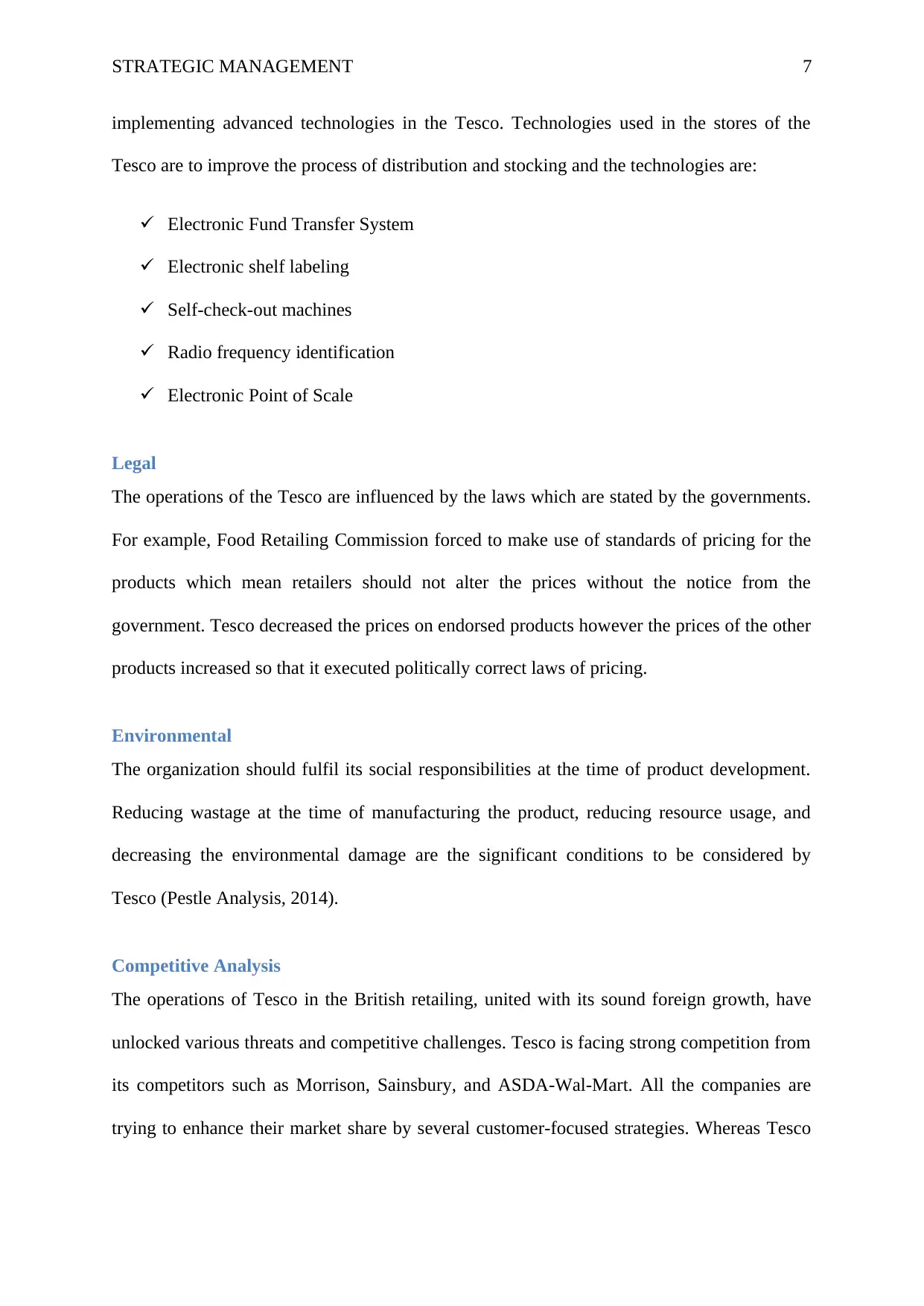
STRATEGIC MANAGEMENT 7
implementing advanced technologies in the Tesco. Technologies used in the stores of the
Tesco are to improve the process of distribution and stocking and the technologies are:
Electronic Fund Transfer System
Electronic shelf labeling
Self-check-out machines
Radio frequency identification
Electronic Point of Scale
Legal
The operations of the Tesco are influenced by the laws which are stated by the governments.
For example, Food Retailing Commission forced to make use of standards of pricing for the
products which mean retailers should not alter the prices without the notice from the
government. Tesco decreased the prices on endorsed products however the prices of the other
products increased so that it executed politically correct laws of pricing.
Environmental
The organization should fulfil its social responsibilities at the time of product development.
Reducing wastage at the time of manufacturing the product, reducing resource usage, and
decreasing the environmental damage are the significant conditions to be considered by
Tesco (Pestle Analysis, 2014).
Competitive Analysis
The operations of Tesco in the British retailing, united with its sound foreign growth, have
unlocked various threats and competitive challenges. Tesco is facing strong competition from
its competitors such as Morrison, Sainsbury, and ASDA-Wal-Mart. All the companies are
trying to enhance their market share by several customer-focused strategies. Whereas Tesco
implementing advanced technologies in the Tesco. Technologies used in the stores of the
Tesco are to improve the process of distribution and stocking and the technologies are:
Electronic Fund Transfer System
Electronic shelf labeling
Self-check-out machines
Radio frequency identification
Electronic Point of Scale
Legal
The operations of the Tesco are influenced by the laws which are stated by the governments.
For example, Food Retailing Commission forced to make use of standards of pricing for the
products which mean retailers should not alter the prices without the notice from the
government. Tesco decreased the prices on endorsed products however the prices of the other
products increased so that it executed politically correct laws of pricing.
Environmental
The organization should fulfil its social responsibilities at the time of product development.
Reducing wastage at the time of manufacturing the product, reducing resource usage, and
decreasing the environmental damage are the significant conditions to be considered by
Tesco (Pestle Analysis, 2014).
Competitive Analysis
The operations of Tesco in the British retailing, united with its sound foreign growth, have
unlocked various threats and competitive challenges. Tesco is facing strong competition from
its competitors such as Morrison, Sainsbury, and ASDA-Wal-Mart. All the companies are
trying to enhance their market share by several customer-focused strategies. Whereas Tesco
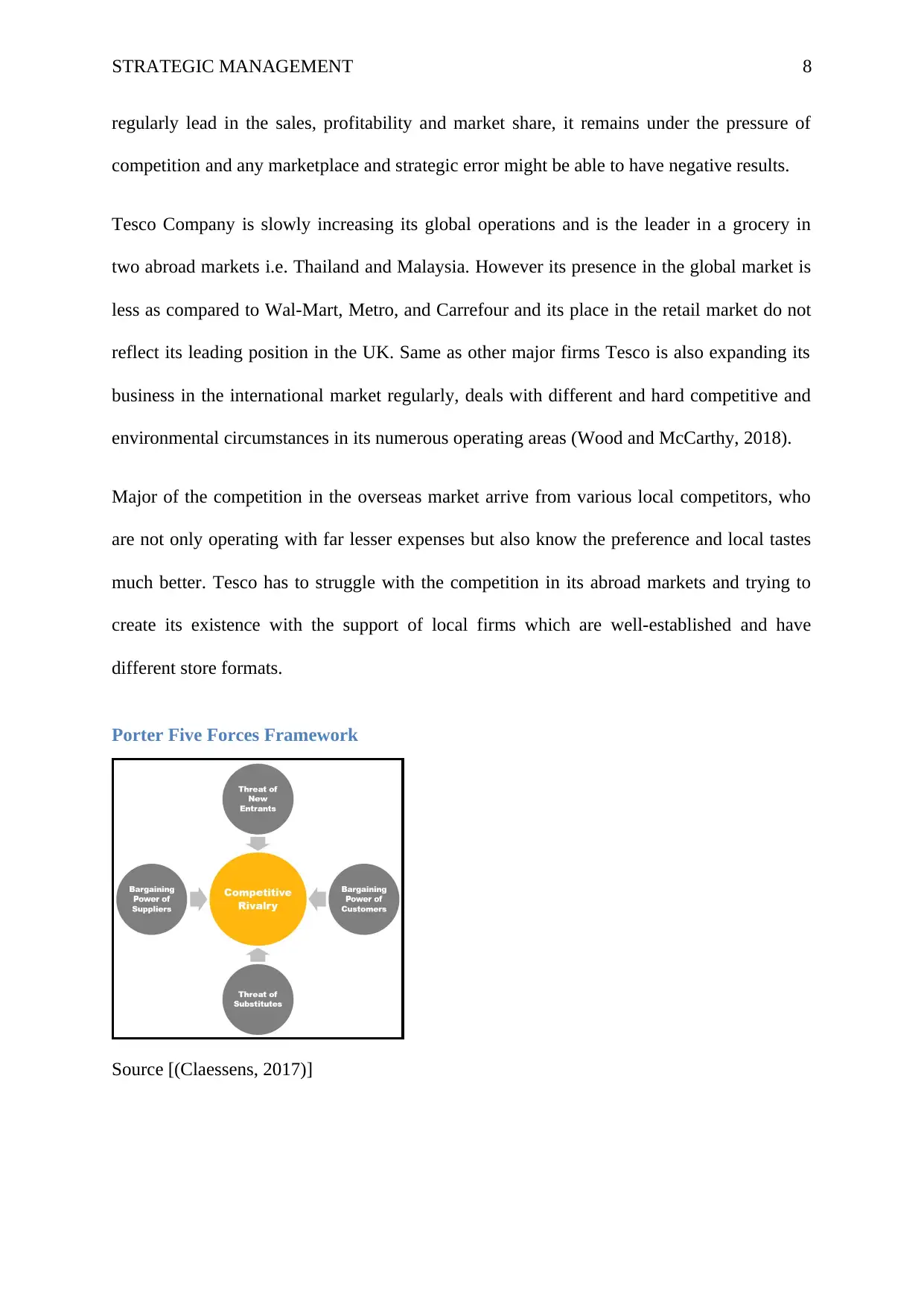
STRATEGIC MANAGEMENT 8
regularly lead in the sales, profitability and market share, it remains under the pressure of
competition and any marketplace and strategic error might be able to have negative results.
Tesco Company is slowly increasing its global operations and is the leader in a grocery in
two abroad markets i.e. Thailand and Malaysia. However its presence in the global market is
less as compared to Wal-Mart, Metro, and Carrefour and its place in the retail market do not
reflect its leading position in the UK. Same as other major firms Tesco is also expanding its
business in the international market regularly, deals with different and hard competitive and
environmental circumstances in its numerous operating areas (Wood and McCarthy, 2018).
Major of the competition in the overseas market arrive from various local competitors, who
are not only operating with far lesser expenses but also know the preference and local tastes
much better. Tesco has to struggle with the competition in its abroad markets and trying to
create its existence with the support of local firms which are well-established and have
different store formats.
Porter Five Forces Framework
Source [(Claessens, 2017)]
regularly lead in the sales, profitability and market share, it remains under the pressure of
competition and any marketplace and strategic error might be able to have negative results.
Tesco Company is slowly increasing its global operations and is the leader in a grocery in
two abroad markets i.e. Thailand and Malaysia. However its presence in the global market is
less as compared to Wal-Mart, Metro, and Carrefour and its place in the retail market do not
reflect its leading position in the UK. Same as other major firms Tesco is also expanding its
business in the international market regularly, deals with different and hard competitive and
environmental circumstances in its numerous operating areas (Wood and McCarthy, 2018).
Major of the competition in the overseas market arrive from various local competitors, who
are not only operating with far lesser expenses but also know the preference and local tastes
much better. Tesco has to struggle with the competition in its abroad markets and trying to
create its existence with the support of local firms which are well-established and have
different store formats.
Porter Five Forces Framework
Source [(Claessens, 2017)]
⊘ This is a preview!⊘
Do you want full access?
Subscribe today to unlock all pages.

Trusted by 1+ million students worldwide
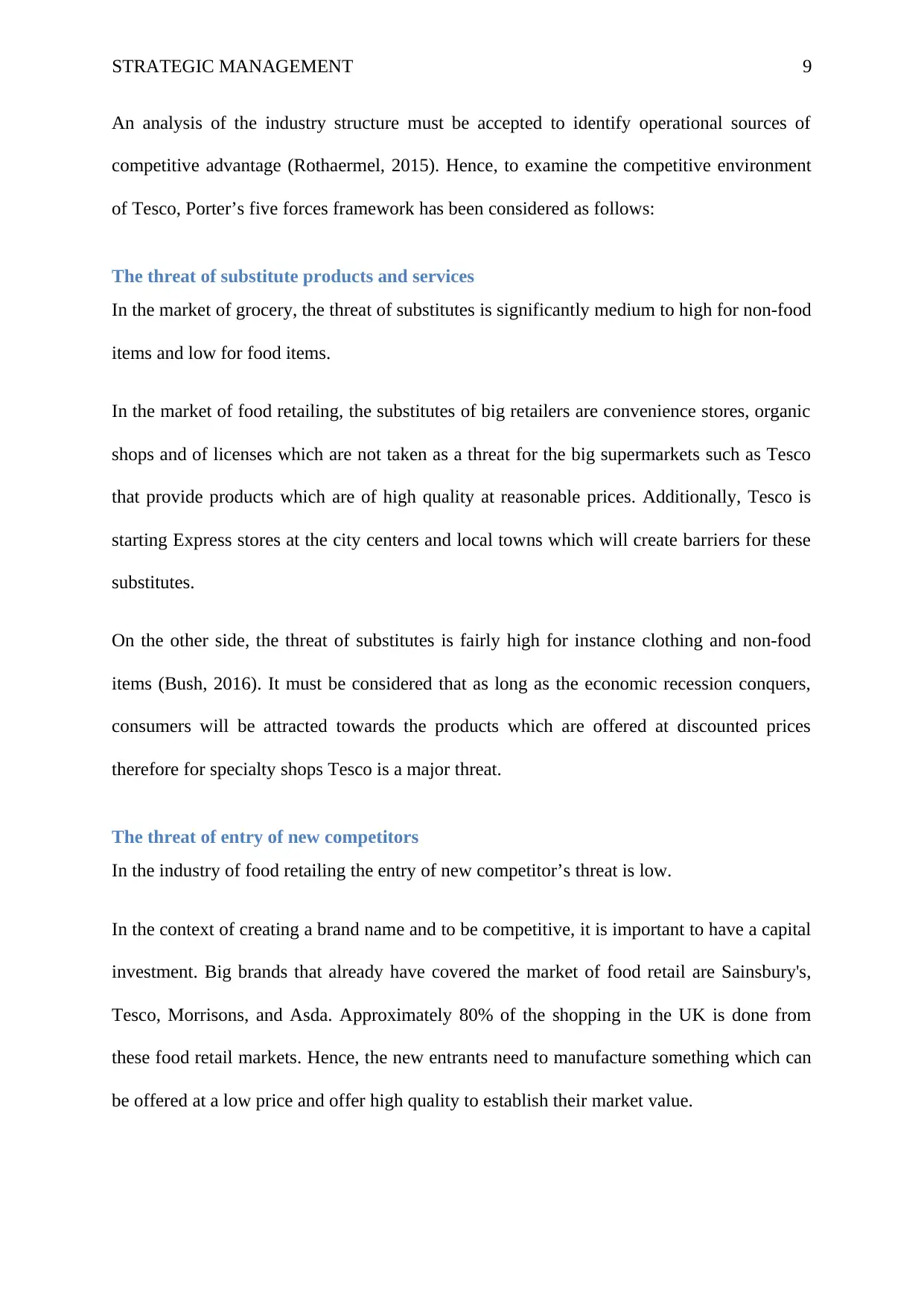
STRATEGIC MANAGEMENT 9
An analysis of the industry structure must be accepted to identify operational sources of
competitive advantage (Rothaermel, 2015). Hence, to examine the competitive environment
of Tesco, Porter’s five forces framework has been considered as follows:
The threat of substitute products and services
In the market of grocery, the threat of substitutes is significantly medium to high for non-food
items and low for food items.
In the market of food retailing, the substitutes of big retailers are convenience stores, organic
shops and of licenses which are not taken as a threat for the big supermarkets such as Tesco
that provide products which are of high quality at reasonable prices. Additionally, Tesco is
starting Express stores at the city centers and local towns which will create barriers for these
substitutes.
On the other side, the threat of substitutes is fairly high for instance clothing and non-food
items (Bush, 2016). It must be considered that as long as the economic recession conquers,
consumers will be attracted towards the products which are offered at discounted prices
therefore for specialty shops Tesco is a major threat.
The threat of entry of new competitors
In the industry of food retailing the entry of new competitor’s threat is low.
In the context of creating a brand name and to be competitive, it is important to have a capital
investment. Big brands that already have covered the market of food retail are Sainsbury's,
Tesco, Morrisons, and Asda. Approximately 80% of the shopping in the UK is done from
these food retail markets. Hence, the new entrants need to manufacture something which can
be offered at a low price and offer high quality to establish their market value.
An analysis of the industry structure must be accepted to identify operational sources of
competitive advantage (Rothaermel, 2015). Hence, to examine the competitive environment
of Tesco, Porter’s five forces framework has been considered as follows:
The threat of substitute products and services
In the market of grocery, the threat of substitutes is significantly medium to high for non-food
items and low for food items.
In the market of food retailing, the substitutes of big retailers are convenience stores, organic
shops and of licenses which are not taken as a threat for the big supermarkets such as Tesco
that provide products which are of high quality at reasonable prices. Additionally, Tesco is
starting Express stores at the city centers and local towns which will create barriers for these
substitutes.
On the other side, the threat of substitutes is fairly high for instance clothing and non-food
items (Bush, 2016). It must be considered that as long as the economic recession conquers,
consumers will be attracted towards the products which are offered at discounted prices
therefore for specialty shops Tesco is a major threat.
The threat of entry of new competitors
In the industry of food retailing the entry of new competitor’s threat is low.
In the context of creating a brand name and to be competitive, it is important to have a capital
investment. Big brands that already have covered the market of food retail are Sainsbury's,
Tesco, Morrisons, and Asda. Approximately 80% of the shopping in the UK is done from
these food retail markets. Hence, the new entrants need to manufacture something which can
be offered at a low price and offer high quality to establish their market value.
Paraphrase This Document
Need a fresh take? Get an instant paraphrase of this document with our AI Paraphraser
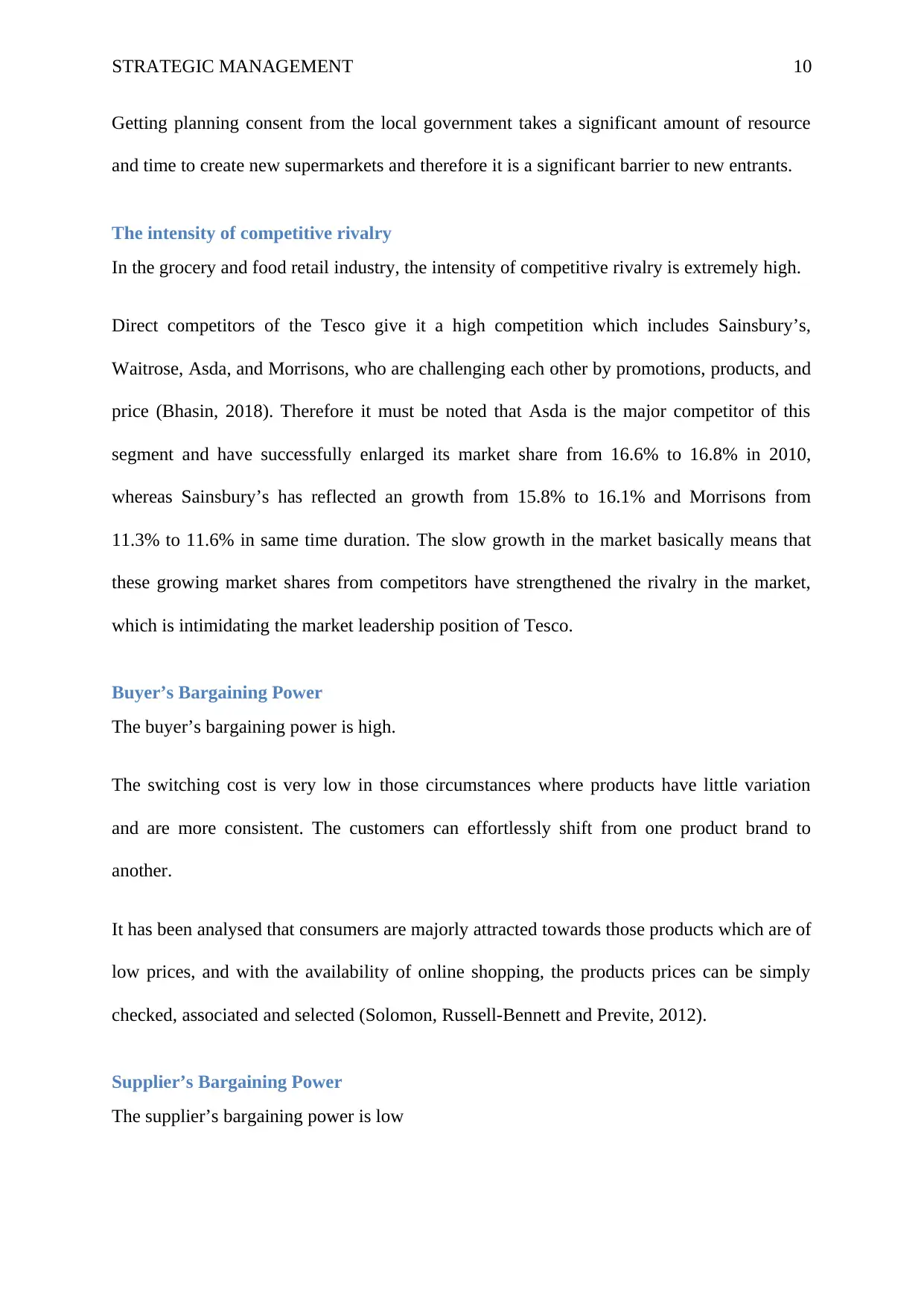
STRATEGIC MANAGEMENT 10
Getting planning consent from the local government takes a significant amount of resource
and time to create new supermarkets and therefore it is a significant barrier to new entrants.
The intensity of competitive rivalry
In the grocery and food retail industry, the intensity of competitive rivalry is extremely high.
Direct competitors of the Tesco give it a high competition which includes Sainsbury’s,
Waitrose, Asda, and Morrisons, who are challenging each other by promotions, products, and
price (Bhasin, 2018). Therefore it must be noted that Asda is the major competitor of this
segment and have successfully enlarged its market share from 16.6% to 16.8% in 2010,
whereas Sainsbury’s has reflected an growth from 15.8% to 16.1% and Morrisons from
11.3% to 11.6% in same time duration. The slow growth in the market basically means that
these growing market shares from competitors have strengthened the rivalry in the market,
which is intimidating the market leadership position of Tesco.
Buyer’s Bargaining Power
The buyer’s bargaining power is high.
The switching cost is very low in those circumstances where products have little variation
and are more consistent. The customers can effortlessly shift from one product brand to
another.
It has been analysed that consumers are majorly attracted towards those products which are of
low prices, and with the availability of online shopping, the products prices can be simply
checked, associated and selected (Solomon, Russell-Bennett and Previte, 2012).
Supplier’s Bargaining Power
The supplier’s bargaining power is low
Getting planning consent from the local government takes a significant amount of resource
and time to create new supermarkets and therefore it is a significant barrier to new entrants.
The intensity of competitive rivalry
In the grocery and food retail industry, the intensity of competitive rivalry is extremely high.
Direct competitors of the Tesco give it a high competition which includes Sainsbury’s,
Waitrose, Asda, and Morrisons, who are challenging each other by promotions, products, and
price (Bhasin, 2018). Therefore it must be noted that Asda is the major competitor of this
segment and have successfully enlarged its market share from 16.6% to 16.8% in 2010,
whereas Sainsbury’s has reflected an growth from 15.8% to 16.1% and Morrisons from
11.3% to 11.6% in same time duration. The slow growth in the market basically means that
these growing market shares from competitors have strengthened the rivalry in the market,
which is intimidating the market leadership position of Tesco.
Buyer’s Bargaining Power
The buyer’s bargaining power is high.
The switching cost is very low in those circumstances where products have little variation
and are more consistent. The customers can effortlessly shift from one product brand to
another.
It has been analysed that consumers are majorly attracted towards those products which are of
low prices, and with the availability of online shopping, the products prices can be simply
checked, associated and selected (Solomon, Russell-Bennett and Previte, 2012).
Supplier’s Bargaining Power
The supplier’s bargaining power is low
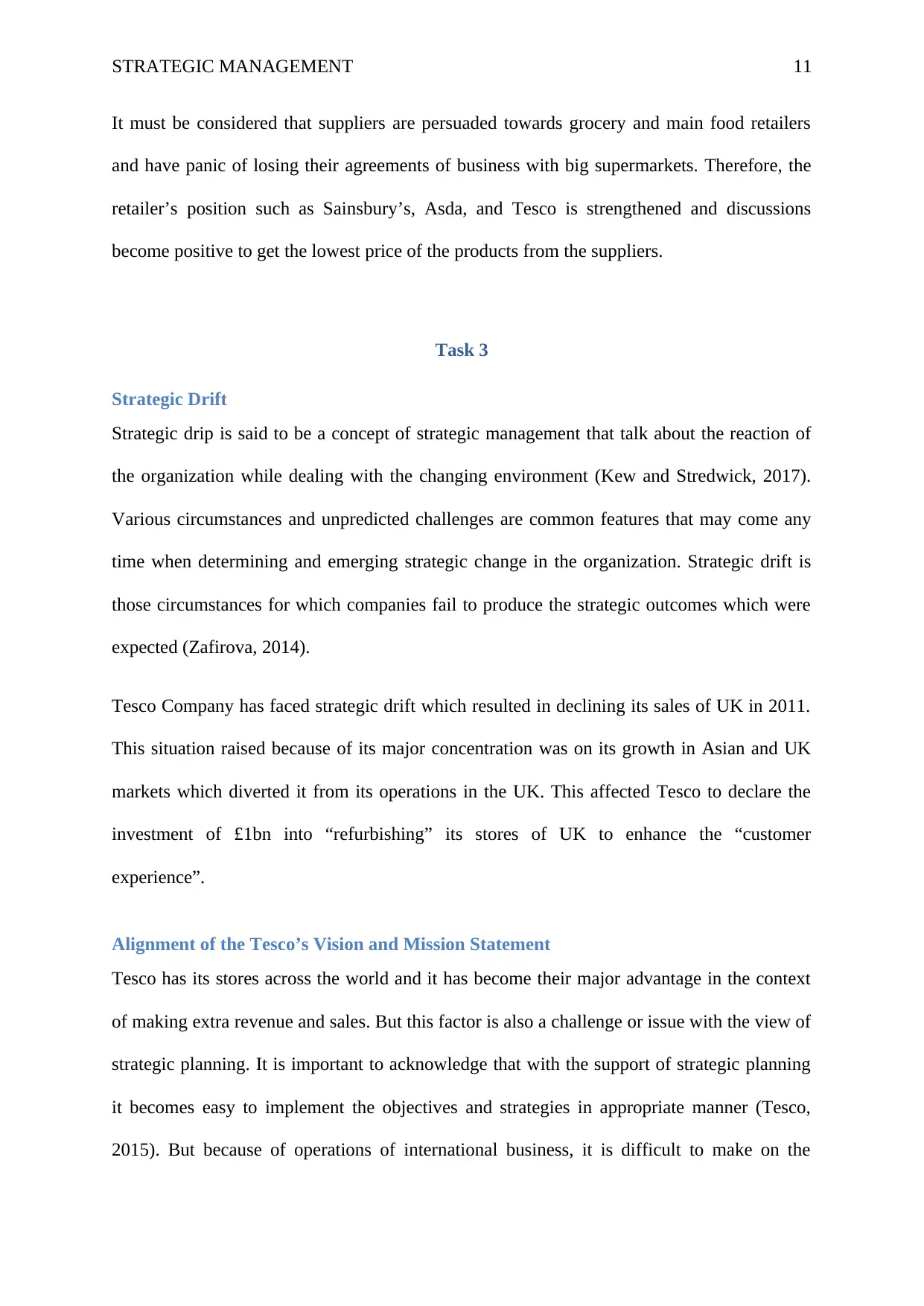
STRATEGIC MANAGEMENT 11
It must be considered that suppliers are persuaded towards grocery and main food retailers
and have panic of losing their agreements of business with big supermarkets. Therefore, the
retailer’s position such as Sainsbury’s, Asda, and Tesco is strengthened and discussions
become positive to get the lowest price of the products from the suppliers.
Task 3
Strategic Drift
Strategic drip is said to be a concept of strategic management that talk about the reaction of
the organization while dealing with the changing environment (Kew and Stredwick, 2017).
Various circumstances and unpredicted challenges are common features that may come any
time when determining and emerging strategic change in the organization. Strategic drift is
those circumstances for which companies fail to produce the strategic outcomes which were
expected (Zafirova, 2014).
Tesco Company has faced strategic drift which resulted in declining its sales of UK in 2011.
This situation raised because of its major concentration was on its growth in Asian and UK
markets which diverted it from its operations in the UK. This affected Tesco to declare the
investment of £1bn into “refurbishing” its stores of UK to enhance the “customer
experience”.
Alignment of the Tesco’s Vision and Mission Statement
Tesco has its stores across the world and it has become their major advantage in the context
of making extra revenue and sales. But this factor is also a challenge or issue with the view of
strategic planning. It is important to acknowledge that with the support of strategic planning
it becomes easy to implement the objectives and strategies in appropriate manner (Tesco,
2015). But because of operations of international business, it is difficult to make on the
It must be considered that suppliers are persuaded towards grocery and main food retailers
and have panic of losing their agreements of business with big supermarkets. Therefore, the
retailer’s position such as Sainsbury’s, Asda, and Tesco is strengthened and discussions
become positive to get the lowest price of the products from the suppliers.
Task 3
Strategic Drift
Strategic drip is said to be a concept of strategic management that talk about the reaction of
the organization while dealing with the changing environment (Kew and Stredwick, 2017).
Various circumstances and unpredicted challenges are common features that may come any
time when determining and emerging strategic change in the organization. Strategic drift is
those circumstances for which companies fail to produce the strategic outcomes which were
expected (Zafirova, 2014).
Tesco Company has faced strategic drift which resulted in declining its sales of UK in 2011.
This situation raised because of its major concentration was on its growth in Asian and UK
markets which diverted it from its operations in the UK. This affected Tesco to declare the
investment of £1bn into “refurbishing” its stores of UK to enhance the “customer
experience”.
Alignment of the Tesco’s Vision and Mission Statement
Tesco has its stores across the world and it has become their major advantage in the context
of making extra revenue and sales. But this factor is also a challenge or issue with the view of
strategic planning. It is important to acknowledge that with the support of strategic planning
it becomes easy to implement the objectives and strategies in appropriate manner (Tesco,
2015). But because of operations of international business, it is difficult to make on the
⊘ This is a preview!⊘
Do you want full access?
Subscribe today to unlock all pages.

Trusted by 1+ million students worldwide
1 out of 24
Related Documents
Your All-in-One AI-Powered Toolkit for Academic Success.
+13062052269
info@desklib.com
Available 24*7 on WhatsApp / Email
![[object Object]](/_next/static/media/star-bottom.7253800d.svg)
Unlock your academic potential
Copyright © 2020–2025 A2Z Services. All Rights Reserved. Developed and managed by ZUCOL.





